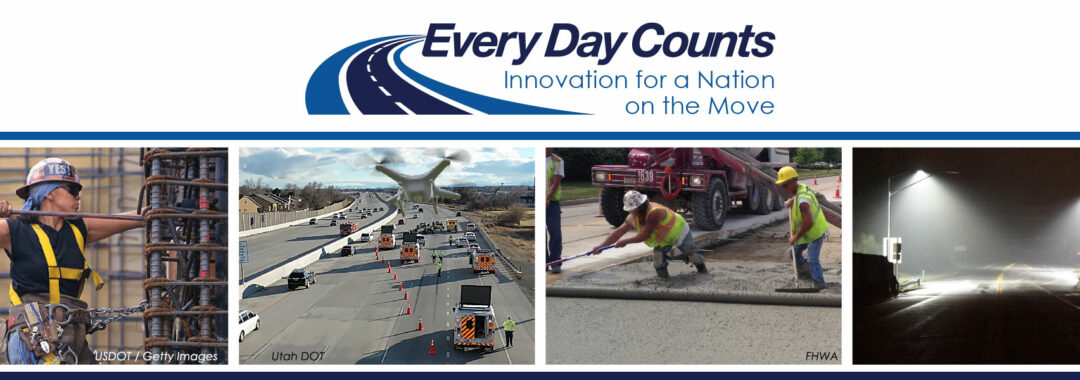Every two years, FHWA works with state transportation departments, local governments, tribes, private industry and other stakeholders to identify and champion a new collection of innovations that merit accelerated deployment through the Every Day Counts Program (EDC). The FHWA’s Center for Accelerating Innovation (CAI) has recently issued the next round of areas of innovation, EDC-7.
EDC is a state-based model that identifies and rapidly deploys proven, yet underutilized innovations to shorten the project delivery process, enhance roadway safety, reduce traffic congestion, and improve environmental sustainability. Proven innovations promoted through EDC facilitate greater efficiency at the state and local levels, saving time, money and resources that can be used to deliver more projects.
FHWA’s CAI fosters collaboration between stakeholders within the transportation community through the State Transportation Innovation Councils (STIC), which are charged with evaluating innovations and spearheading their deployment in each state.
![]() More information on the EDC-7 Innovations will be presented at the EDC-7 Virtual Summit, scheduled for February 14-16, 2023. Transportation leaders and front-line professionals from across the country will discuss and identify opportunities for implementing the innovations that best fit the needs of their respective state transportation program. Shortly after the Virtual Summit, an NJ STIC Caucus will be convened on February 22, 2023 to finalize the selection of innovations, establish baseline condition and performance goals for innovation deployment over the upcoming two-year cycle, and form leadership and technical teams to support the implementation of each of the chosen innovations.
More information on the EDC-7 Innovations will be presented at the EDC-7 Virtual Summit, scheduled for February 14-16, 2023. Transportation leaders and front-line professionals from across the country will discuss and identify opportunities for implementing the innovations that best fit the needs of their respective state transportation program. Shortly after the Virtual Summit, an NJ STIC Caucus will be convened on February 22, 2023 to finalize the selection of innovations, establish baseline condition and performance goals for innovation deployment over the upcoming two-year cycle, and form leadership and technical teams to support the implementation of each of the chosen innovations.
In announcing its EDC-7 innovations, FHWA emphasized its commitment to a focus on safety for all users, sustainable infrastructure, and inclusive workforce development. Descriptions of each of the EDC-7 Innovations are below:
Nighttime Visibility for Safety. The nighttime crash fatality rate is three times the daytime rate. Enhancing visibility along corridors, intersections, and pedestrian crossings can help reduce fatalities. This initiative promotes traffic control devices and properly designed lighting to improve safety for all users.
Next Generation TIM: Technology for Saving Lives. Over six million crashes a year in the U.S. put responders and other vulnerable road users at risk. Next-Generation Traffic Incident Management programs promote emerging technologies such as emergency vehicle lighting and queue warning solutions. These and other tools can advance safety and operations to mitigate incident impacts.
Integrating GHG Assessment and Reduction Targets in Transportation Planning. Transportation is the largest emitter of greenhouse gases in the U.S. This initiative provides resources to help agencies quantify greenhouse gases and set goals to decrease motor vehicle, construction, and life-cycle emissions through planning and project development.
Enhancing Performance with Internally Cured Concrete (EPIC2). Cracking in concrete is a limiting factor in achieving long-term concrete performance. Internal curing mitigates shrinkage cracking and has the potential to substantially extend the service life of concrete bridge decks and enhance the performance of pavements and repairs.
EPDs for Sustainable Project Delivery. Construction materials such as concrete and asphalt have environmental impacts during their life cycle. Environmental product declarations, or EPDs, document those impacts. This tool helps States support procurement decisions and quantify embodied carbon reductions using life cycle assessments for sustainable pavements.
Rethinking DBE in Design-Build. Many disadvantaged business enterprise program procedures do not adequately address design-build contracting. New practices are available to support the effective integration of program requirements to help small, disadvantaged businesses compete for design-build contracts.
Strategic Workforce Development. The demand for highway workers is growing, and emerging technologies require new skills. This innovation helps stakeholders improve their ability to identify, train, and place highway construction workers. The focus will expand to rural and Tribal communities to increase career opportunities.

